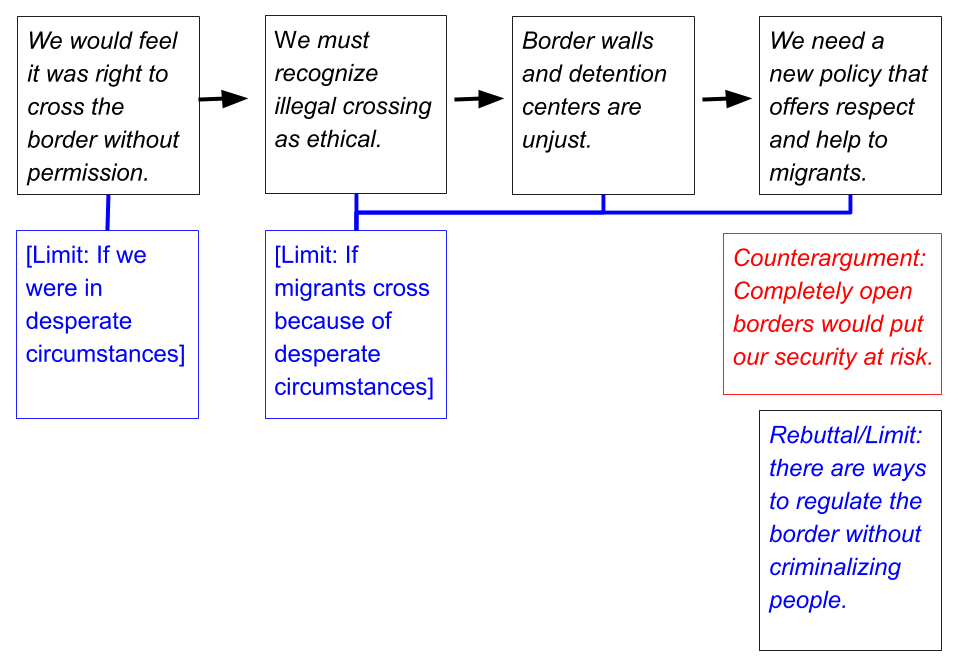3.5: Putting the Summary Together
- Page ID
- 45443
How can we turn the descriptions of the claims, reasons, counterarguments, and limitations into a cohesive paragraph, page, or essay that we can turn in as our summary? The good news is that by introducing each part of the argument to show how it relates to the others, we have already provided many of the transitions we need. We can generate a first draft of the summary by simply putting them all together in order.

Here is an example of a summary draft that describes the border argument:
Sample Summary
In her 2019 article “Wouldn’t We All Cross the Border?”, Anna Mills urges readers to seek a new border policy that helps desperate undocumented migrants rather than criminalizing them. She calls for a shift toward respect and empathy, questioning the very idea that crossing illegally is wrong. Mills argues that any parent in a desperate position would consider it right to cross for their child’s sake; therefore, no person should condemn that action in another. Since we cannot justify our current walls and detention centers, we must get rid of them. She acknowledges that opening the borders completely would compromise security, but believes that we can still “regulate” our borders without blocking or imprisoning migrants.
Next, we can review our border argument map to make sure that we have covered the main parts of the argument.

"Argument Map with Limits" by Anna Mills is licensed CC BY-NC 4.0.
See the accessible text description of the argument map with limits.
If we are writing a longer summary of an extended argument, our map and our knowledge of the role of each part of the text will help us organize the essay into paragraphs and transition between them. For example, in a three-page summary of a twenty-five-page essay, we might spend a full paragraph on the author’s description of a counterargument and yet another paragraph on the author’s rebuttal to this counterargument. To open this paragraph, we could refer to our earlier list of templates for describing a response to a counterargument.
Practice Exercise 3.6.13.6.1
Summarize the argument below in a few sentences that introduce each element of the argument and its role. If you completed the exercises for the earlier sections in this chapter, you may use some of those answers to those to help you put together this paragraph.
Coffee is a blessing to students. What better way is there to jumpstart the mind and help us engage with our studies? The benefits of coffee are well known, and yet some hold back from it unnecessarily. Some feel that black tea is a better choice, arguing that it can still boost mental performance with fewer side effects. This depends on the individual. While black tea is worth considering, remember that it still comes with side effects, and for many, it simply will not give enough of a boost to the brain. For those of us who believe in the life of the mind, enhancing our brains’ abilities is ultimately of more value than avoiding the occasional minor discomfort. Of course, a few people who experience severe side effects like anxiety, insomnia, or tremors should avoid coffee. For most, though, we can drink coffee in moderation and still feel healthy, as long as we exercise and sleep well. Some object to coffee because they believe that ingesting any substance to help us study leads to addiction. They worry that even a boost to mental functioning will ultimately hurt us because it encourages us to try to fix our mind with substances any time we feel out of sorts. This argument, however, is nothing short of paranoid. It would result in some ridiculous conclusions. By its logic, if we drink water when we’re thirsty, we will end up addicted. If you haven’t given coffee a fair try under the right circumstances, don’t deprive yourself out of fear. Chances are you can do better work and enjoy it more with a moderate coffee habit. Why let life’s “Aha” moments pass you by?


.jpg?revision=2)